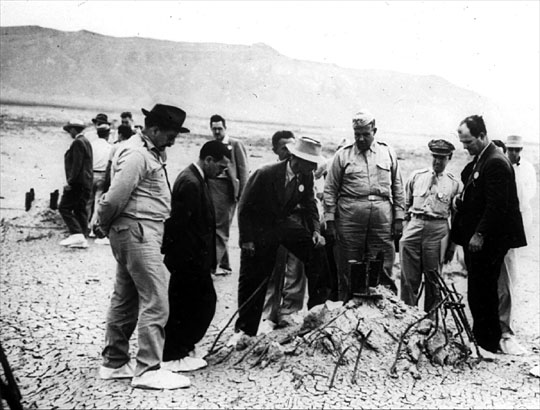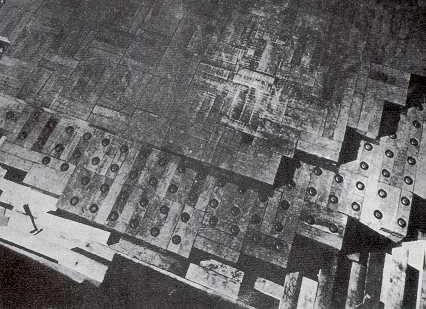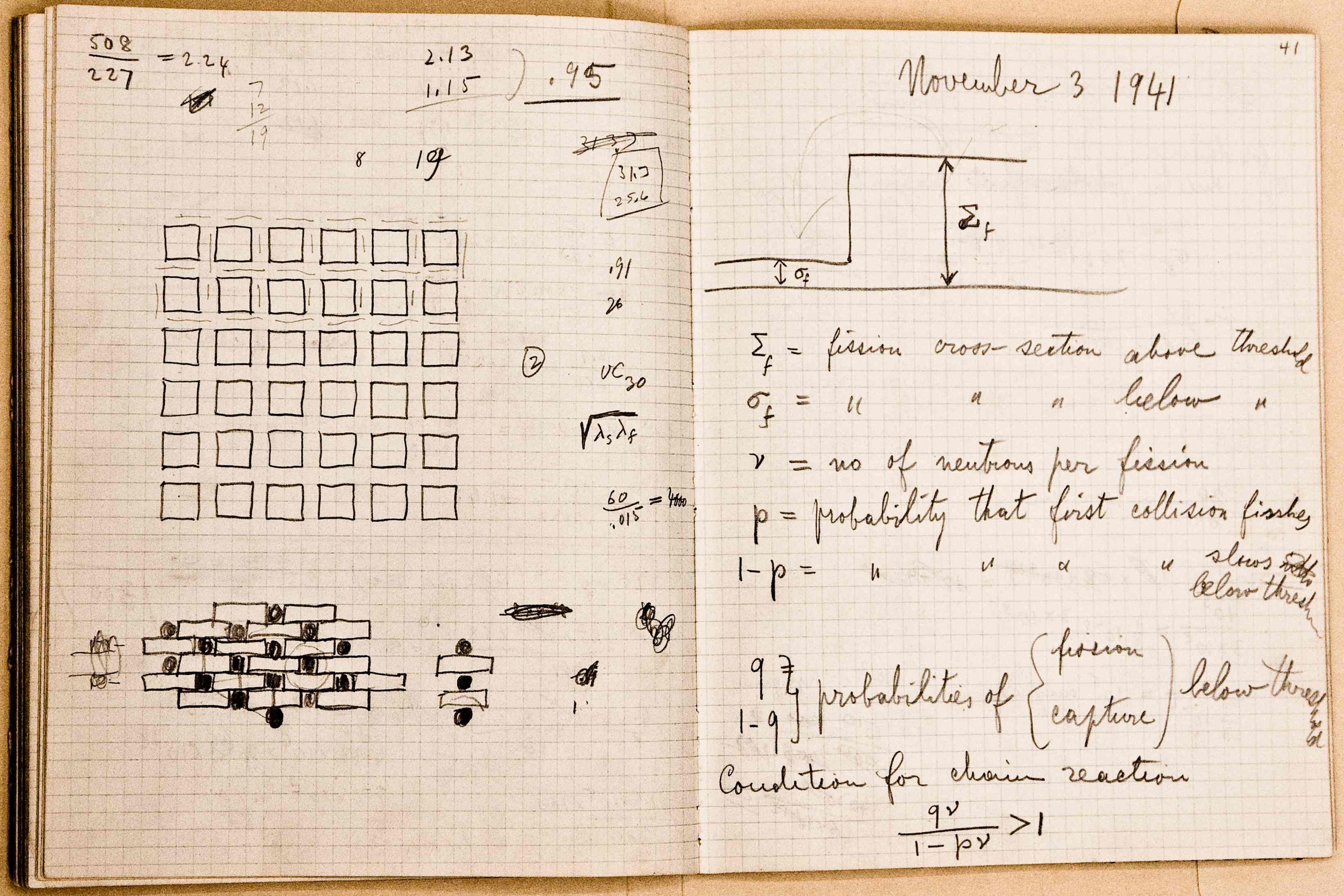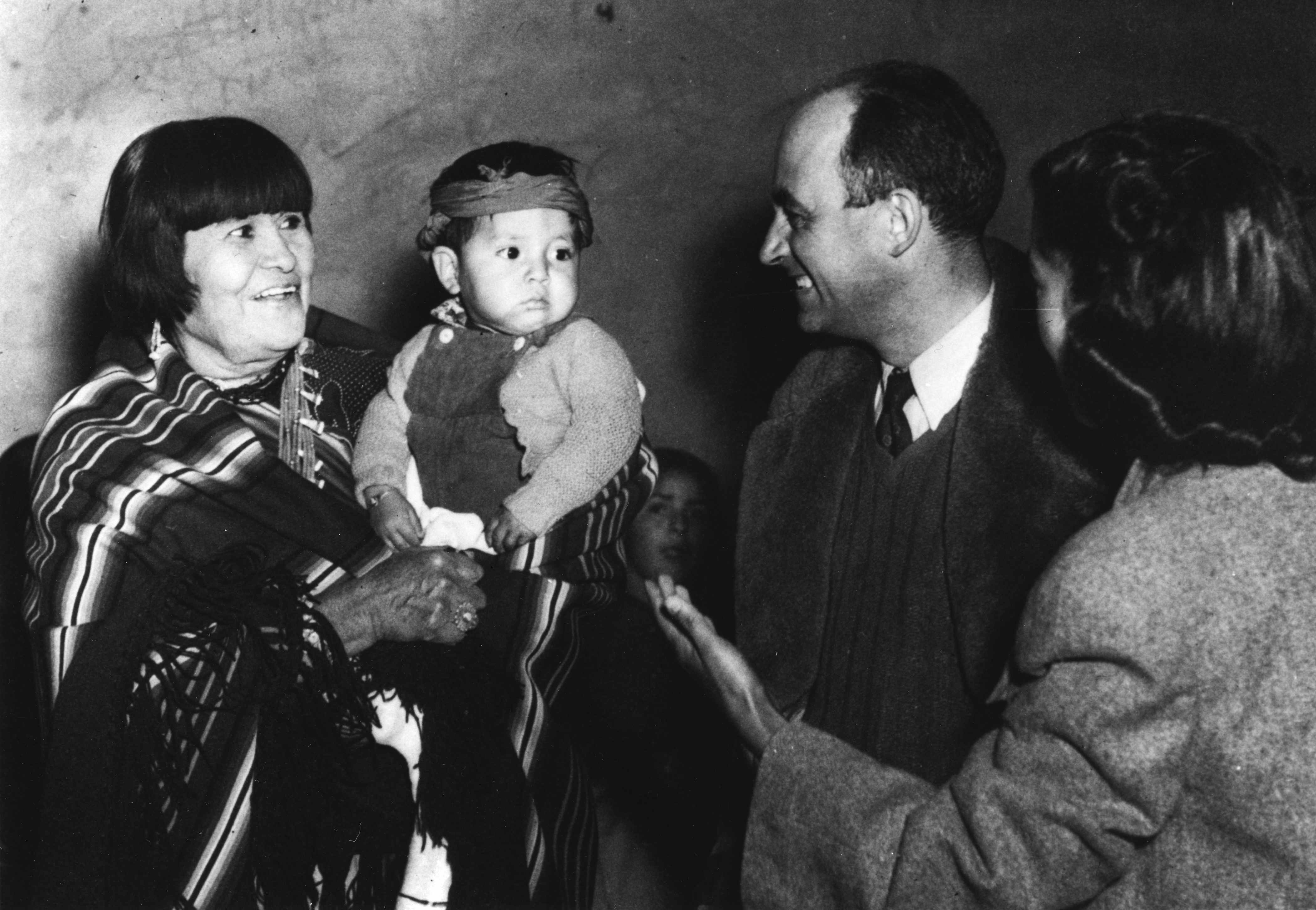Neutron Trail: Key Terms
Here in my own words is a glossary of key terms, acronyms and Fermi Effect lingo. As you browse this page, I hope you will get a feel for the Neutron Trail itself – with its layers of events and experiences, criss-crossing times, people and places.
Have a new question? Want me to add something? Just ask and I will consider inclusion here. Curiosity leads to awareness…. Awareness leads to solutions! -of
CP-1. Chicago Pile 1. See Pile.

Model of CP-1 at the Museum of Science and Industry, Chicago, IL. Photo: Olivia Fermi © 2010
Fermi Effect. Raises more questions than answers.
How do my grandfather Enrico’s contributions in the areas of science, technology and mentorship continue their influence today?
How does the Fermi Effect inform the nuclear legacy we all share? What does the legacy mean to me and my family and to our human family?
Like a quantum wave, Laura Fermi exemplifies another aspect of the Fermi Effect. My grandmother became an influential author and activist after her husband’s early death. How do we as informed citizens influence society? How do we learn to make wise choices to protect the environment and utilize technology in ways which promote health, peace and human dignity?
Fundamentally, the Fermi Effect is not something Enrico Fermi invented or discovered (although the scientific journal Nature published in 1934: Experiments on the Fermi Effect). It’s not unique to my grandmother or anyone else named Fermi. Yet, the Fermi Effect continues its ever-widening influence. Scientists utilize the scientific method and strategic determination to understand the physics of the universe. We citizens, including all the scientists and everyone else, each have the opportunity to transfer those same skills into a humanistic context to better tackle the difficult questions of human survival in the years to come.
Fermi, Enrico. My grandfather was a neutron genius and a genius at strategic problem determination, analysis and solution. He won the Nobel Prize in Physics in 1938 for methodically unveiling properties of elements bombarded by slow neutrons. His theories, practical applications and most especially his mentorship continue to have a ripple effect. He was an inventor, a much loved teacher and colleague, a father, a trail blazer, team builder, competitive, generous and steady. He died of stomach cancer a few years before I was born.
Fermi, Laura. My grandmother was a wife, a mother, a New York Times best selling author, an early environmentalist and pioneer in the hand gun control movement, indelibly strong willed, even in the face of physical limitations, to follow a project to completion. She was the first to exemplify for me what it is to be a human systems thinker and environmental activist.

The site in southern New Mexico where the first atomic bomb was detonated (code-named Trinity) on July 16, 1945. To obtain an unconditional surrender from Japan in a very agressive climate of war, the US Army under the direction of President Truman dropped two atomic bombs, one on Hiroshima and one on Nagasaki, within weeks of the Trinity test. Pictured above are Robert Oppenheimer, civilian project director and General Leslie Groves, military director (3rd & 4th from left).
After World War II, the meaning of Ground Zero broadened to include any inhabited place where there’s been a major violent explosion. Velcrow Ripper, filmmaker, visited Ground Zero’s of the planet to find hope for humanity in place of human tragedy and destruction. His film Scared Sacred (2004) covers trips to Hiroshima, Japan where an atomic bomb was dropped on August 6, 1945 immediately killing 25% – 50% of the population and Manhattan, USA, site of the September 11, 2001 destruction of the World Trade Center.
(Also see Trinity.)
LAHDRA. Acronym for Los Alamos Historical Document Retrieval and Assessment. This is the US Centers for Disease Control (CDC) study which documents, among other aspects of operations at LANL, the damaging health effects of the Trinity test (see Trinity) on local residents. The draft LAHDRA report is available online. the final report is scheduled to be released in Sept 2010.
LANL. Los Alamos National Lab continues as a classified US military installation. It’s biggest job is Mission Stockpile Stewardship (see Plutonium). In contrast, Oak Ridge National Lab (ORNL), TN is now dedicated to open science. Both LANL and ORNL are run by the US government.
Los Alamos, New Mexico, USA. During the Manhattan Project (WWII), the top scientists worked here to design and build the first atomic bombs. Currently, Los Alamos is the site of Los Alamos National Laboratory (See LANL)
Manhattan Project. Top secret US government project to build the first atomic bombs. 1942 – 1945. Located primarily in Los Alamos, NM, where the scientists including my grandfather Enrico developed the bomb; Hanford, WA, where the plutonium was refined; and Oak Ridge, TN, where the uranium was prepared.
Background. In the 1930′s, Germany rose in power under Hitler, a man who believed Jews and blacks were inferior to Aryan’s (white people). His reign of terror, exterminating Jews and others, was called Nazism and directly led to World War II. A group of countries called the Allies, including Russia, Britain and the USA, fought the Axis powers, Germany, Italy and Japan.
My grandfather Enrico and many other scientists fled Nazi-controlled territory and came to the USA. The US military invited Enrico and other scientists to join the Manhattan Project to build an atomic bomb to stop the Nazi’s. By the time the scientists had the bomb ready, the Nazi’s had lost their grip. Meanwhile Japan’s ambitions to conquer the Pacific reached the shores of the USA with the bombing of Pearl Harbor, a port
Neutron. In the earlier part of the last century, atoms were made of neutrons, protons and electrons. Neutrons are the atomic particles without charge. Along with positively charged protons they make up the nucleus of the atom.
Some people are born musicians, others fix cars. My grandfather Enrico Fermi was a natural for neutrons.
Sidebar: Enrico Fermi won the Nobel Prize in Physics in 1938 for bombarding each element in the periodic table with slow neutrons. This allowed him to escape Fascist Italy with my Jewish grandmother Laura, my mom Nella and her brother Giulio.
After they fled Rome, there was a round up of Jews there. My grandmother’s father, an Admiral in the Italian Navy, was taken from his 3rd floor apartment in Rome and did not survive the train ride to a concentration camp. He had refused to leave, believing his rank and patriotism would protect him. Tragically and miraculously, my great-grandfather’s sister was on the 4th floor of the same building at the same time her brother was taken. She was not discovered. End of Sidebar.
Neutron Trail. Term coined by me, Olivia Fermi, to describe a specific open-ended personal and cultural inquiry. Denotes the actual and metaphysical placeholders and resulting connections of the atomic age of significance to humanity now. Stops along the Neutron Trail include: FermiLab in Chicago, Los Alamos, New Mexico and Japan. What else I’ve discovered and continue to learn as I follow the Neutron Trail is what this blog is all about. (Also see Fermi Effect).
Pile.

Enrico Fermi named the pile of uranium he assembled in an abandoned squash court under the football stadium at the University of Chicago the Pile. It was also called CP-1 for Chicago Pile #1. He used cadmium rods inserted in the pile of uranium to control the radioactivity and achieved the first controlled, self-sustaining nuclear chain reaction on December 2, 1942. Some have likened this event to the discovery of fire, because like fire, atomic energy can be used to benefit us or to destroy.
Of course, there are a lot of ways atomic energy is not at all like fire.
My grandfather was a team builder who believed in open dialogue in science not secrecy. However, CP-1 was part of a top secret project during World War II called the Manhattan Project. There was enough threat to the free world at the time (from World War II, Hitler, Nazism, extermination of Jews and other peoples) to lead many citizens, including scientists, to agree to behaviors such as extraordinary secrecy.

Page from Enrico Fermi’s notebook, courtesy University of Chicago Special Collections. Photo: Olivia Fermi © 2008.
The Pile was the first nuclear reactor. It demonstrated the controlled release of atomic energy; and suggested atomic bombs were possible.
Plutonium. A highly lethal radioactive element created from uranium to build atomic bombs starting in World War II.
As yet, humankind has not figured out an efficient, safe way to store plutonium nor a way to transform it back into something more benign. Currently, vast sums of money, human and technological resources are required to guard and care for the existing plutonium.
At LANL (see Los Alamos), this job of caring for atomic weapons (with the plutonium inside) is called Mission Stockpile Stewardship. It involves ongoing testing of everything to do with the bombs to make sure they remain ‘safe and reliable’. It also involves massive and complex computer simulations and testing.
Much at LANL is classified information. I don’t know the exact budget of Mission Stockpile Stewardship, or if it is possible to determine, but it is obviously in the billions of dollars category. Even if the world powers agreed to dismantle all the nuclear weapons in the world, we still need to figure out what to do with the plutonium!
Trinity. Code name for the test site of the first atomic bomb on July 16, 1945. Located in a remote section of desert, south of Albuquerque, New Mexico called Jornada del Muerto (journey of the dead man). At the time, scientists and the military thought they were the only ones to witness the test. Within days, the reality that residents, livestock, food and water within even a thirty mile radius were affected by the Trinity test had hit at least some in the military. Cattle irradiated by the atomic bomb blast on the side facing the mushroom cloud turned white. Some but not all of these cattle were confiscated by the military. Radioactive fallout fell on the area for days. Likely due to secrecy on the part of the military, lack of information on the part of locals combined with a natural reluctance to complain in public and a strong amount of patriotism all-around, the full story of the impact on US citizens is only coming to light decades later. (see LAHDRA.)

Maria Martinez, local artisan holding baby, meets Enrico Fermi, Manhattan Project, physicist.
Robert Oppenheimer and others collected Maria’s pottery. While attending a commemoration ceremony on July 16, 2010 with families of victims and survivors of the Trinity test, to hear stories and to speak, I met Martinez’ grand-daughter Kathy Sanchez. Sanchez is a local envirnomental and social justice advocate. Based on what I’ve learned about the situation at the time, my sense is scientists, like my grandfather, who had been kept separate from the military, had no way of knowing the Trinity test had harmed civilians.



